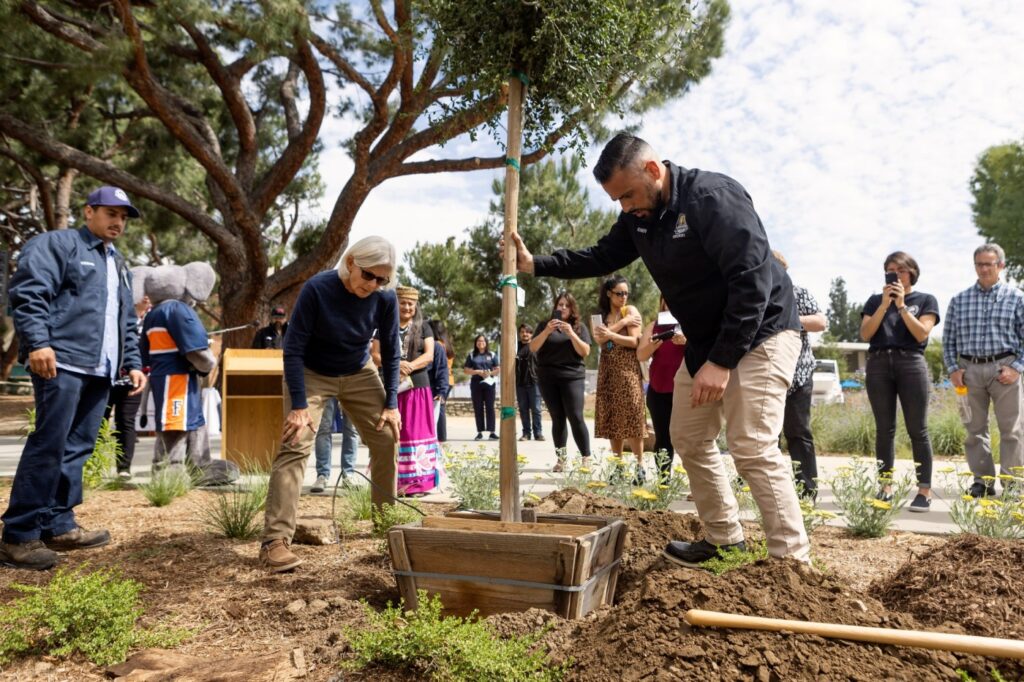
Seven serve as a memorial to lives needlessly taken.
One received the blessing of the Dalai Lama.
Others pay homage to local history.
But symbolism and aesthetics aside, each of the more than 2,000 trees earthed throughout the Cal State Fullerton campus serves multiple purposes.
“Trees help improve air quality, have positive effects on human health, economy, infrastructure, preserve soil, support wildlife, conserve water, and provide oxygen,” said Hans Mickelson, manager of Landscape Services and certified arborist with CSUF Capital Programs & Facilities Management.
At Cal State Fullerton’s Arbor Day festivities in April, the university’s inventory of trees expanded with a total of 10 trees planted at five locations around campus.
In recent years, more native trees such as the Coast Live Oak are being planted because they support indigenous species, are more drought and disease tolerant, don’t need heavy trimming and live much longer than non-native trees, Mickelson said.
Additionally, the roots of Coast Live Oak do not seek water in shallow soil but have a wide and deep expanding root system, which supports soil from erosion and is less likely to damage nearby sidewalks and structures, the arborist said.
Hardwood trees in general sequester roughly 48 pounds of carbon dioxide each year, Mickelson said, and have sequestered up to a ton of carbon dioxide by the time they are 40 years old.
Honoring their memory
The most meaningful of the campus trees are the seven stone pines in between the Pollak Library and the Kinesiology & Health Science Building.
Those make up Memorial Grove, honoring the seven victims killed in a mass shooting on campus on July 12, 1976.
On that day, a campus janitor shot and killed Frank Teplansky, 51 Debbie Paulsen, 26, Stephen L. Becker, 32, Seth Fessenden, 72, Paul F. Herzberg, 30, Bruce A. Jacobson, 32, and Donald E. Karges, 41.
Wounded were Maynard Hoffman, 64, and Donald W. Keran.
The incident was the worst mass killing in Orange County history until the Seal Beach Salon mass shooting on Oct. 12, 2011.
After the April 16, 2007, mass shooting at Virginia Tech claimed 32 lives and left 19 wounded, Fullerton Arboretum director Greg Dyment was contacted by a Virginia Tech faculty member who was researching an appropriate way to honor that university’s victims and had learned about the CSUF shooting.
“I was a little surprised to learn that CSUF was the only U.S. university campus that had a living memorial,” Dyment said. “I thought there would have been more than just ours but apparently, we are it. I remember his comment to me just before we ended that phone conversation: ‘It is very special to have a living memorial; don’t ever lose it. If a tree dies, replant another immediately.’”
Recalling the past
Perhaps the most sacred tree on campus is the Bodhi tree blessed by the Dalai Lama during his visit to CSUF on June 28, 2000.
The Bodhi tree was then planted on the grounds of the Fullerton Arboretum on Sept. 13, 2000, by a group of Cal State Fullerton faculty who represented the five major world religions.
The Arboretum, incidentally, was designed to occupy the land that once held the remnants of the Gilman Ranch and the location of the first commercial orange grove in the area, Dyment said.
In an article Dyment penned for “Public Garden,” he wrote: “Our citrus collection today contains the eight original healthy trees left from Gilman’s grove and an additional 40 that have been planted since the Arboretum opened, representing 15 varieties.”
CSUF’s 236-acre campus was built on a portion of the vast orange grove, which made up a portion of the Gillman Ranch.
The state of California purchased the land in 1959 for the purpose of building the university.
When the business building (formerly Mihaylo College) was constructed in 2008, officials added mini orange groves on both sides of the building to pay homage to the history of the region as a citrus hub.
A third orange grove is situated adjacent to the Humanities building.
While the history and age of the campus trees are not fully known, their age can be estimated by DBH (diameter at breast height), a tool by arborists to gauge tree health, which can then determine their method of care.
“Judging on the caliper of DBH for some of the trees, I would guess there are some that are well over 30 to 40 years old, Mickelson said.
The Italian stone pines located off of Nutwood and the Shamel Ash trees located in the Commons area could be in that 30- to 40-year-old range, he said.
But one of CSUF’s trees isn’t really a tree at all.
Some might argue that CSUF’s logo — an orange tree icon with mountains and sun rays in the background — is as much a part of the university’s identity as the soil preserving, oxygen spreading, life giving trees on campus.
When the university changed its logo from the “Tuffy the Titan” icon to the orange tree icon in 2009, then CSUF President Milton Gordon wrote in a letter that the orange tree not only “recalls our past, our presence in Orange County and the campus orange grove origins,” it also stands “as a symbol of academic and personal growth, knowledge and transformation.”
Related Articles
Summer session at CSUF offers students convenience, flexibility
Titan Voices: First Indian American person to lead CSUF
OC grads prepare to cap another year at colleges, universities
CSUF’s Mathematics Department grant really adds up
CSUF’s nursing program prepares students to serve diverse populations
